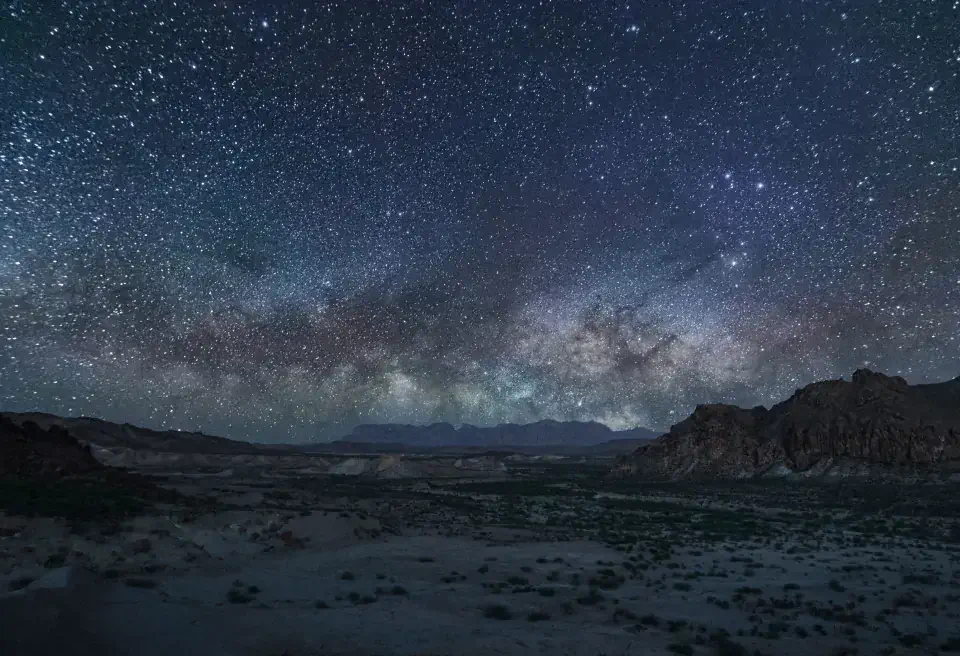Warm nights, breathtaking views of the Milky Way and meteor showers make summer a great time to stargaze! With more than 60 dark sky parks, communities and reserves in the US designated as International Dark Sky Places (including 12 National Parks), it’s never been easier to find somewhere to talk to the moon or wish upon a star.
Not sure where to start? Here are some of our favorite places to stargaze:
Big Bend National Park, TX
Big Bend has the least light pollution of any National Park in the US. Fly into El Paso or Midland, rent a car and stop at Santa Elena Overlook or Mules Ears View Point along the Ross Maxwell Scenic Drive for the best views. If you have time, head over to neighboring Big Bend Ranch State Park for International Dark-Sky Association (IDA) gold-tier rated night sky views. Be sure to get a reservation if you’re planning to stay at the lodge or campgrounds within the National Park, and be wary of the summer heat during your daytime adventures!
Central Idaho Dark Sky Reserve, ID
Located in the Sawtooth National Recreation Area, the Central Idaho Dark Sky Reserve was the first IDA gold-tier sky recognized in the US. The reserve is a conglomeration of local parks and communities coming together to manage light pollution, preserve the outdoors and support the dark sky experience. Join their mission by being sure to follow Leave No Trace principles and learning how you can help minimize light pollution. The Reserve has several suggested star viewing lookouts for those who just want to stop in, but you’ll need to make reservations for campsites in advance on recreation.gov if you plan to spend the night under the stars.
Tucson, AZ
If camping isn’t exactly your thing, where better to go than the city that calls itself home to the IDA? Head to Sky Bar for a telescope tour along with your cocktail. Ready to level up? Astronomy stores like Stellar Vision & Starizona offer binoculars, telescopes and stargazing resources. Astronomy hotspots like Saguaro National Park, Mt. Lemmon, and Oracle State Park are just short drives from the city, so you can get both your fix of top-notch Southwest Cuisine and constellations, all while still staying close enough to the city to relax in a hotel once the night is over.
Natural Bridge State Park & Sky Meadows State Park, VA
Stargazing can be difficult east of the Mississippi, where light pollution and clusters of major cities create obstacles for stargazers. Enter Natural Bridge State Park & Sky Meadows State Park, which both gained International Dark Sky Place (IDSP) status in April 2021 and made Virginia the state with the most IDSPs east of the Mississippi. Why not take a Virginia road trip to connect them all?
Black Canyon of the Gunnison National Park, CO
Black Canyon of the Gunnison is one of the darkest and least-visited National Parks, despite being only 22 minutes from Montrose airport. If you’re looking for some alone time with the stars this might just be the place for you. The park uses artificial lighting only for safety, with motion-detectors limiting light to only when needed. Park at any of the viewpoints along the South Rim Road to roll out a blanket and view the Milky Way, particularly Chasm View, Dragon Point and Sunset View which have overviews slightly away from the main road and are shielded from the headlights of other visitors.
Feeling like more of a local road trip? Check the IDSP map to find a dark sky location close to you. (Don’t forget to rent a car early to get the best price!)
So you’ve booked your flight, found a spot, brewed your hot cocoa and rolled out your blanket. Now what? Here’s what to look for if you’re a first-time stargazer:
- The Summer Triangle is composed of stars from 3 constellations: Vega (the fifth brightest star in the sky) in Lyra, Deneb in Cygnus and Altair in Aquila. The summer triangle acts as a frame for the Milky Way, which flows directly through it. Look to the East just after nightfall and you’ll see a bright blue star, Vega, high in the sky. Look down to the lower right of Vega (about the length of a ruler if you held your hand out directly in front of you) and you’ll find Altair. Deneb will be to the lower left of Vega, about one hand’s length away if you hold your hand out directly in front of you.
- Sagittarius, which looks like a teapot with four stars for the handle, three stars to form the spout and a one-star lid can be found low in the Southern Sky during the Summer. Its spout points toward the center of the Milky Way and appears to be pouring right into it. Just to the right of Sagittarius, you’ll find Scorpio, distinguished by a large red star, Antares, burning right where the heart of the scorpion would be. Look slightly up and to the right of Antares and you’ll see three stars in a line, forming the head of the scorpion.
- The Perseid meteor shower is set to peak between August 11-13. A new moon on August 8th means that competing light from the moon will be at a minimum. Head out just after midnight and look for Cassiopeia, a constellation shaped like a “W” to the Northeast. The first point of the “W” points to the Double Cluster in the constellation Perseus, the radiant point of the meteor shower.
- Jupiter and Saturn both reach their opposite point from the Sun as seen from Earth in August 2021, making them the brightest and easiest to find. Look for them in the low Southeast sky just after sunset.
Pro tips:
- Bring binoculars if you have ‘em! A telescope isn’t the only way to get a closer view of your favorite stars.
- Keep the lights off and use a red light flashlight to preserve your night vision when looking at star maps or moving around.
- The moon can outshine the stars and make some constellations harder to recognize. Go stargazing during a new moon to see the stars at their best.
- Attend a night sky program at a National Park to learn more about light pollution and preserving the night sky, get help finding tricky constellations or to get a closer look through a telescope.
Happy stargazing!






